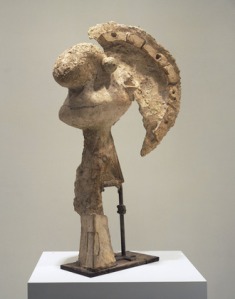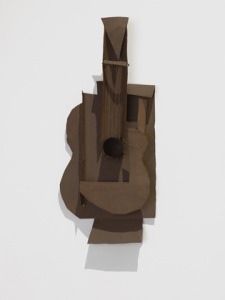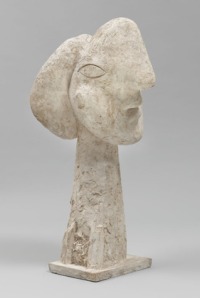1. Baboon and Young, 1955, Bronze
2. Head of a Warrior, 1942.
3. Guitar, 1914. Ferrous sheet metal and wire.
4. Head of a Woman, 1932. Plaster.
5. Pregnant Woman, 1950. Plaster, Metal, Wood, Ceramic, Pottery Jars.
Artist Statement:
“It has always been typical of Picasso that he could not be captured within a single net. He was this, he was that, he was the other- at one moment a poet, at the next an inspired buffoon…” — John Canaday, New York Times.
Picasso’s “Pregnant Woman” sculpture: Subject vs Content
“Pregnant Woman”, by Pablo Picasso, is a sculpture that was completed in 1950. The medium of the sculpture consist of plaster with metal armature, wood, ceramic vessel, and pottery jars. The dimensions of the sculpture are 43 1/4 x 8 5/8 x 12 1/2″ (110 x 22 x 32 cm). The sculpture, as its name claims, depicts a woman who appears to be near the end of her pregnancy. It is a tanned colored sculpture and the belly of the sculpture shows a bit of the pottery jar that the artist used.
This sculpture is obviously representative of the experience that women undergo while pregnant. The rough look of the plaster might be representative of the toll that pregnancy takes on the physical body of women. The body appears to be very swollen and the posture of the woman definitely gives the audience a sense of pain, frustration, and discomfort.
The posture of the woman with her body standing upright, her arms and legs stiff, and her hands clenched might be representative of the sacrifice that woman are willing to make by enduring the pain involved with pregnancy to allow life to continue. The artist might have had a strong relationship with his own mother and may have wanted to pay her and women in general a tribute.




